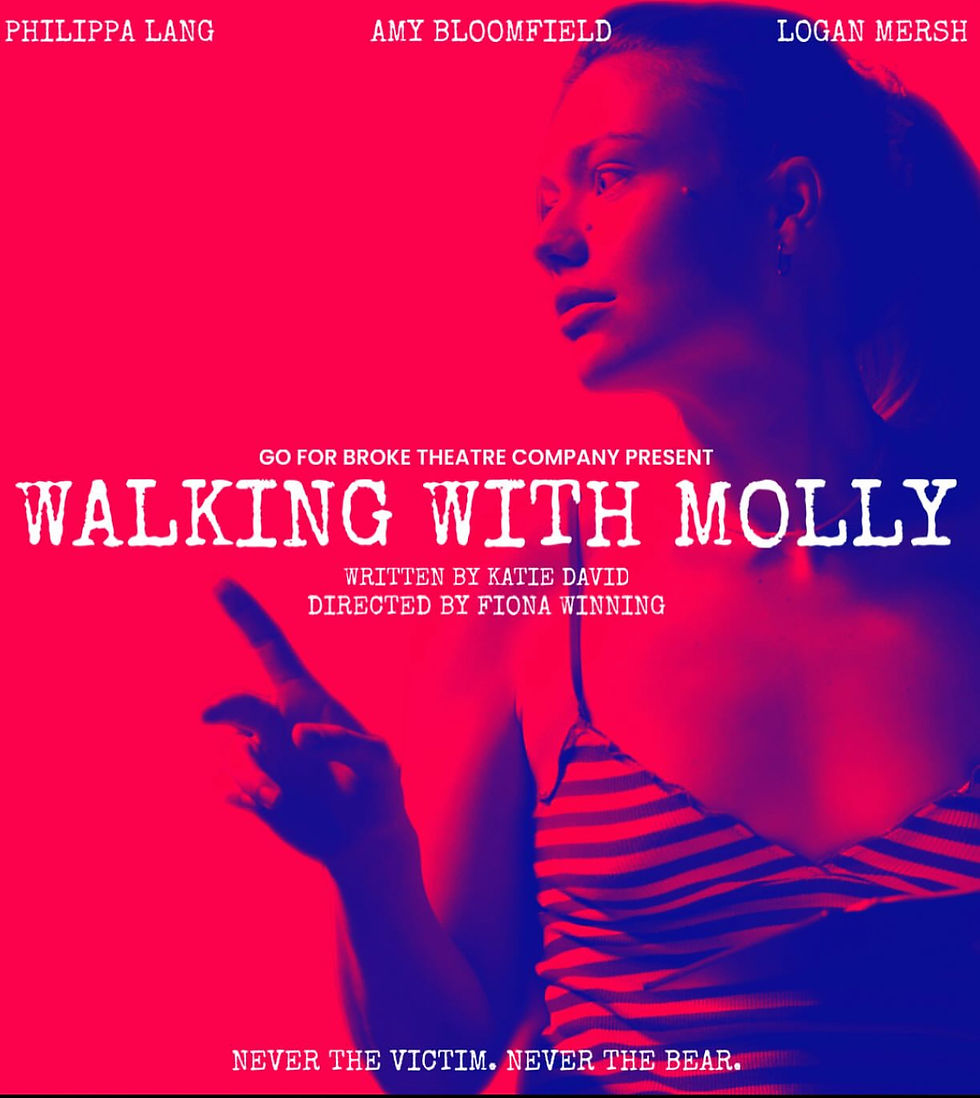Walking With Molly at Riverside Studios: Influencer Culture on the Edge
- London Theatre Doc
- Aug 3
- 3 min read
Go For Broke’s bold satire tackles internet fame and its fallout with unsettling honesty.

We have all watched someone go viral and thought, would I want that? Walking With Molly, written by Katie David and directed by Fiona Winning, holds that thought under a microscope. Blending satire and discomfort, it explores the appeal of internet fame and the quiet unravelling that follows when your personality becomes a product. There are laughs, sure, but they come with a wince.
Molly gives an offhand, drunken answer to a street interview question — “Would you rather be followed home by a man or a bear?” — and within hours, the internet cannot stop watching. The clip explodes. She leans into the attention, building a brand around messy nights out, staged dates, and performative vulnerability. Walking With Molly explores what happens when a viral moment becomes your entire identity, and what is left when the views start to dip.
The show’s strongest asset by far is Logan Mersh as “The Man,” who plays nine different characters throughout the piece. He shapeshifts through a string of repulsive, hilarious and painfully familiar male personas, each one a cringe-inducing red flag. Among the standouts are Mr Conspiracy, all paranoia and podcast energy, Football Man, a laddish charmer whose past reveals something far more disturbing, and Mr Adventure who masks entitlement as spiritual growth. Each character is sharply drawn and full of comic detail. It is a masterclass in character work, uncomfortable in all the right ways. He does not just play these men, he exposes them.
In contrast, the female characters, while central to the structure, often feel like vehicles for the satire rather than fully lived-in people. Philippa Lang gives a grounded performance as Molly, capturing flashes of frustration and self-awareness with an eye-roll or a well-timed sigh. Her physicality is strong and her presence believable, but the internal collapse the story seems to promise never truly materialises. The final scene, which suggests Molly’s mild distress after a drunken, unconsented sexual encounter, feels like it should be the show’s emotional peak, but instead, it lands without impact. What could have offered real dramatic weight becomes a quiet fade-out, a moment that passes rather than transforms.

Amy Bloomfield, as sister Sasha, serves as a neat foil: pragmatic, composed, and a reminder of a life beyond the feed. But she too struggles to leave a lasting impression. Her lines do the job, but they rarely cut through, and I found myself searching my notes days later to recall even one clear moment.
The show raises important questions, but too often it lets them slip away. A key example is the moment where consent is brushed against and then quickly forgotten, left unexamined in the rush of scenes. In a story centred on performative femininity, blurred boundaries and the dangers of visibility, these moments could offer real weight. Instead, they fade into the background, leaving the satire sharp in tone but soft in impact.
Visually, Fiona Winning creates a compelling environment. Projected clips of Molly’s social content flicker on the walls, blurring the line between screen and stage. The set, her chaotic bedroom, is cleverly used to show the real person behind the filtered image. These transitions are seamless and often striking. Though well-realised, the realism occasionally feels too unfiltered. A more stylised approach could have pushed the satire further. Just like with “The Man,” the show succeeds most when it exaggerates. A few sharper physical touches, such as Molly actively creating chaos while her sister genuinely tidies, would have helped reinforce the contrast and make its ideas more tactile.
Despite its flaws, Walking With Molly has something to say, and the bones of something strong are already here. It is hard to watch, but in the best way. It is messy, quick, and unafraid to look ridiculous. It holds a mirror up to how we present ourselves online and how quickly performance can become identity.
It made me reflect on my own relationship with social media and the small, strange performances we all engage in. The show does not just parody influencer culture, it explores the deeper need to be seen and the compromises that follow. With more clarity and a stronger grip on its darker moments, Walking With Molly has the potential to be a standout hit at Fringe festivals and beyond. The voice is already there. It just needs to speak louder.




Comments